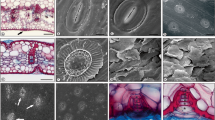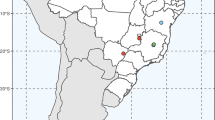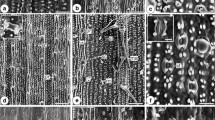Abstract
Quesnelia is an endemic genus of the Atlantic Forest in Brazil. It features 21 species and three varieties that are distributed from Santa Catarina to Bahia, with diversity centers in the Rio de Janeiro coastal region and the rainforest of southern Bahia. It is divided into the subgenera Quesnelia subg. Quesnelia and Quesnelia subg. Billbergiopsis. In this study, the leaf anatomy of all species of Quesnelia is characterized and compared by multivariate analysis to determine whether leaf anatomy confirms this subgeneric division. The results demonstrate that leaf anatomy supports the existence of three distinct groups of species now classified under the genus Quesnelia. When compared to other species, the first group, which is represented by five Billbergiopsis taxa, is characterized by distinct anatomical arrangement, where the stomata are positioned at the same level as the epidermis, the water storage tissue is poorly developed, and extra-fascicular fiber strands are distributed throughout the mesophyll. The remaining groups support the subgenera Quesnelia and Billbergiopsis, which differ basically in terms of the contour of the leaf in transverse sections, size and cell type of the adaxial water storage tissue, and the presence of extra-fascicular fiber strands. Comparing with anatomical data available in the literature for Bromelioideae, these results indicate the similarity of Quesnelia with Aechmea, Canistrum and Billbergia, which corroborates morphological and molecular phylogenies, and thus support future taxonomic circumscriptions of these important genera from the core Bromelioideae.





Similar content being viewed by others
References
Almeida VR, Costa AF, Mantovani A, Gonçalves-Esteves V, Arruda RCO, Forzza RC (2009) Morphological phylogenetics of Quesnelia (Bromeliaceae—Bromelioideae). Syst Bot 34:660–672
Amorim AMA, Leme EMC (2009) Two new species of Quesnelia (Bromeliaceae—Bromelioideae) from the Atlantic Rainforest of Bahia, Brazil. Brittonia 61:14–21
Aoyama EM, Sajo MG (2003) Estrutura foliar de Aechmea Ruiz & Pav. subg. Lamproccocus (Beer) Baker e espécies relacionadas. Rev Bras Bot 26:461–473
Arruda RCO, Costa AF (2003) Foliar anatomy of five Vriesea sect. Xyphion (Bromeliaceae) species. Selbyana 24:180–189
Baker JG (1889) Handbook of the Bromeliaceae. George Bell & Sons, London
Barfuss MHJ, Samuel R, Till W, Stuessy TF (2005) Phylogenetic relationships in subfamily Tillandsioideae (Bromeliaceae) based on DNA sequence data from seven plastid regions. Am J Bot 92:337–351
Benzing DH (1990) Vascular epiphytes. Cambridge University Press, New York
Benzing DH (2000) Bromeliaceae: profile of an adaptive radiation. Cambridge University Press, Cambridge
Braga MMN (1977) Anatomia foliar de Bromeliaceae da Campina. Acta Amazonica 7(suplemento):1–74
Clarke KR, Gorley RN (2011) Software PRIMER v5. PRIMER-E, Plymouth
Crayn DM, Terry RG, Smith AC, Winter K (2000) Molecular systematic investigations in Pitcairnioideae (Bromeliaceae) as a basis for understanding the evolution of crassulacean acid metabolism (CAM). In: Wilson KL, Morrison DA (eds) Monocots: systematics and evolution. CSIRO Publishing, Collingwood, pp 569–579
Crayn DM, Winter K, Smith JAC (2004) Multiple origins of crassulacean acid metabolism and the epiphytic habit in the neotropical family Bromeliaceae. Proc Natl Acad Sci USA 101:3703–3708
Derwidueé FS, Gonzalez AM (2010) Anatomía foliar en Bromeliaceae del nordeste argentino y Paraguay. Bonplandia 19(2):153–173
Duarte HM (1998) Variabilidade fenotípica intra e interpopulacional em caracteres morfológicos e anatômicos em populações alopátricas de Quesnelia quesneliana Lindman (Bromeliaceae) sob distintos regimes de luz. MSc Dissertation, Universidade Federal do Rio de Janeiro
Faria APG, Wendt T, Brown GK (2004) Cladistic relationships of Aechmea (Bromeliaceae-Bromelioideae) and allied genera. Ann Mo Bot Gard 29:303–319
Forzza RC (2001) Filogenia da tribo Puyeae Wittm. e revisão taxonômica do gênero Encholirium Mart. ex Schult. & Schult. f. (Pitcairnioideae—Bromeliaceae). Ph.D. Dissertation, Universidade de São Paulo
Forzza RC, Costa A, Siqueira Filho JA, Martinelli G (2010) Bromeliaceae. In: Lista de Espécies da Flora do Brasil. Jardim Botânico do Rio de Janeiro. (http://floradobrasil.jbrj.gov.br/2010/FB006335)
Gerrits PO, Smid L (1983) A new, less toxic polymerization system for the embedding of soft tissues in glycol methacrylate and subsequent preparing of serial sections. J Microsc 132:81–85
Givnish TJ, Millam KC, Berry PE, Systma KJ (2007) Phylogeny, adaptive radiation and historical biogeography of Bromeliaceae inferred from ndhF sequence data. In: Columbus JT, Friar EA, Porter JM, Prince LM, Simpson MG (eds) Monocots: comparative biology and evolution—Poales. Rancho Santa Ana Bot Garden, Claremont, pp 3–26
Givnish TJ, Barfuss MHJ, Van EB, Riina R, Schulte K, Horre R, Gonsiska PA, Jabaily RS, Crayn DM, Smith JAC, Winter K, Brown GK, Evans TM, Holst BK, Luther H, Till W, Zizka G, Berry PE, Systma KJ (2011) Phylogeny, adaptive radiation and historical biogeography in Bromeliaceae Insights from an eight-locus plastid phylogeny. Am J Bot 98:872–895
Horres R, Schulte K, Weising K, Zizka G (2007) Systematics of Bromelioideae (Bromeliaceae)—evidence from molecular and anatomical studies. In: Columbus JT, Friar EA, Porter JM, Prince LM, Simpson MG (eds) Monocots: comparative biology and evolution—Poales. Rancho Santa Ana Bot Garden, Claremont, pp 27–43
Leme EMC (2005) Three new miscellaneous species of Bromeliaceae from Bahia, Brazil. J Brom Soc 55:13–22
Leme EMC (2008) A new Quesnelia species from Bahia. J Brom Soc 58:269–271
Leme EMC, Kollmann LJC (2011) Two new species from Alto Cariri State Park, Minas Gerais, Brazil. J Brom Soc 61:54–64
Mantovani A, Magalhães N, Teixeira ML, Leitão G, Staines CL, Resende B (2005) First report on host plants and feeding habits of the leaf beetle Acentroptera pulchella Guérin-Ménevill (Chrysomelidae, Hispinae). In: Konstantinov A, Tishechkin A, Penev L (eds) Contributions to systematics and biology of beetles. Papers celebrating the 80th birthday of Igor Konstantinovich Lopatin. Pensoft Publishers, Sofia, pp 153–157
Mantovani A, Filartiga AL, Coelho MN (2010) Anatomia da folha e espata de espécies de Anthurium (Araceae) da Mata Atlântica. Rev Bras Bot 33:185–200
Martinelli G, Vieira CM, Gonzalez M, Leitman P, Piratininga A, Costa AF, Forzza RC (2008) Bromeliaceae da Mata Atlântica Brasileira: lista de espécies, distribuição e conservação. Rodriguésia 59:209–258
MCune B, Mefford MJ (1999) PC-ORD version 4.0: multivariate analysis of ecological data, users guide. MjM Software Design, Glaneden Beach. Oregon, USA
Mez C (1896) Bromeliaceae. In: Candolle ALPP, Candolle ACP (eds) Monographiae Phanerogamarum, vol 9. G. Massom, Paris, pp 1–990
Monteiro RF (2009) Estudos anatômicos e filogenéticos em Bromelia L. (Bromeliaceae—Bromelioideae). MSc Dissertation, Jardim Botânico do Rio de Janeiro, Rio de Janeiro
Monteiro RF, Forzza RC, Mantovani A (2011) Leaf structure of Bromelia and its significance for the evolution of Bromelioideae (Bromeliaceae). Plant Syst Evol 293:53–64
O’Brien TP, Mccully ME (1981) The study of plants structure, principles and selected methods. Termarcarphi, Melbourne
Patterson TB, Givnish TJ (2002) Phylogeny, concerted convergence, and phylogenetic niche conservatism in the core Liliales: insights from rbcL and ndhF sequence data. Evolution 56:233–252
Proença SL, Sajo MG (2007) Anatomia foliar de bromélias em áreas de cerrado do estado de São Paulo, Brasil. Acta Bot Bras 21:657–673
Reinert F, Russo CAM, Salles LO (2003) The evolution of CAM in the subfamily Pitcairnioideae (Bromeliaceae). Bio J Linn Soc 80:261–268
Rex M, Schulte K, Zizka G, Peters J, Vasquez R, Ibisch PL, Weising K (2009) Phylogenetic analysis of Fosterella L.B. Sm. (Pitcairnioideae, Bromeliaceae) based on four chloroplast DNA regions. Mol Phylogenet Evol 51:472–485
Robinson H (1969) A monograph on foliar anatomy of the genera Connellia, Cottendorfia and Navia (Bromeliaceae). Sm C Bot 2:1–41
Ruzin SE (1992) Plant microtechnique and microscopy. Oxford University Press, New York
Sajo MG, Machado SR, Camello-Guerreiro SM (1998) Aspectos estruturais de folha de bromélia e suas implicações no agrupamento de espécies. In: Pereira MV (ed) Bromélias da Mata Atlântica: Canistropsis. Salamandra, Rio de Janeiro, pp 102–111
Sass C, Spech CD (2010) Phylogenetic estimation of the core bromelioids with emphasis on the genus Aechmea (Bromeliaceae). Mol Phylogenet Evol 55:559–571
Scarano FR, Duarte HM, Rôças G, Barreto SMB, Amado F, Reinert F, Wendt T, Mantovani A, Lima HRP, Barros CF (2002) Acclimation or stress sympton? An integrated study of intraspecific variation in the clonal plant Aechmea bromeliifolia, a widespread CAM tank-bromeliad. Bot J Linn Soc 140:391–402
Schulte K, Zizka G (2008) Multi locus plastid phylogeny of Bromelioideae (Bromeliaceae) and the taxonomic utility of petal appendages and pollen characters. Candollea 63:209–255
Schulte K, Horres R, Zizka G (2005) Molecular phylogeny of Bromelioideae and its implications on biogeography and the evolution of CAM in the family. Senckenbergiana Biologica 85:113–125
Schulte K, Barfuss MHJ, Zizka G (2009) Phylogeny of Bromelioideae (Bromeliaceae) inferred from nuclear and plastid DNA loci reveals the evolution of the tank habit within the subfamily. Mol Phylogenet Evol 51:327–339
Smith LB, Downs RJ (1979) Bromelioideae (Bromeliaceae). Flora Neotropica Monograph 14:1493–2141
Sousa GM, Estelita MEM, Wanderley MGL (2005) Anatomia foliar de espécies brasileiras de Aechmea subg. Chevaliera (Gaudich. ex Beer) Baker, Bromelioideae—Bromeliaceae. Rev Bras Bot 28:603–613
Taylor DC, Robinson H (1999) A rejection of Pepinia (Bromeliaceae: Pitcairnioideae) and taxonomic revisions. Harvard Pap Bot 4:203–217
Tomlinson PB (1969) Commelinales-Zingiberales. In: Metcalf CR (ed) Anatomy of the monocotyledons. Claredon Press, Oxford, pp 193–294
Vargens FAC (2008) Anatomia foliar de espécies de Billbergia Thunb. (Bromeliaceae, Bromelioideae). MSc Dissertation, Universidade Federal do Rio de Janeiro, Rio de Janeiro
Vieira CM (1999) Uma nova espécie de Quesnelia (Bromelioideae: Bromeliaceae) para o Brasil. Bradea 8:131–134
Vieira CM (2006) Quesnelia Gaudich. (Bromelioideae: Bromeliaceae) do estado do Rio de Janeiro, Brasil. Pesquisas Botânica 57:7–102
Voltolini CH, Santos M (2011) Variações na morfo-anatomia foliar de Aechmea lindenii (E.Morren) Baker var. lindenii (Bromeliaceae) sob distintas condições ambientais. Acta Bot Bras 25:2–10
Wanderley MGL, Proença SL (2006) Nova espécie de Quesnelia Gaudich. (Bromeliaceae) do estado de São Paulo, Brasil. Hoehnea 33:111–113
Wawra HRF (1880) Die Bromeliaceen-Ausbeute von der Reise der Prinzen August und Ferdinand von Sachsen-Cobourg nach Brasilien 1879. Oesterr Bot Zeitschrift 30:148–151
Acknowledgments
The authors wish to thank Andre Amorim and Elton Leme for making part of the samples used here available, as well as Jorge Nessimian for assistance with statistical analysis; and Conselho Nacional de Desenvolvimento Científico e Tecnológico (CNPq), Coordenadoria de Aperfeiçoamento do Pessoal de Nível Superior (CAPES) and Fundação de Amparo à Pesquisa do Estado do Rio de Janeiro (FAPERJ) for fellowships.
Author information
Authors and Affiliations
Corresponding author
Rights and permissions
About this article
Cite this article
Mantovani, A., da Venda, A.K.L., Almeida, V.R. et al. Leaf anatomy of Quesnelia (Bromeliaceae): implications for the systematics of core bromelioids. Plant Syst Evol 298, 787–800 (2012). https://doi.org/10.1007/s00606-012-0590-z
Received:
Accepted:
Published:
Issue Date:
DOI: https://doi.org/10.1007/s00606-012-0590-z




